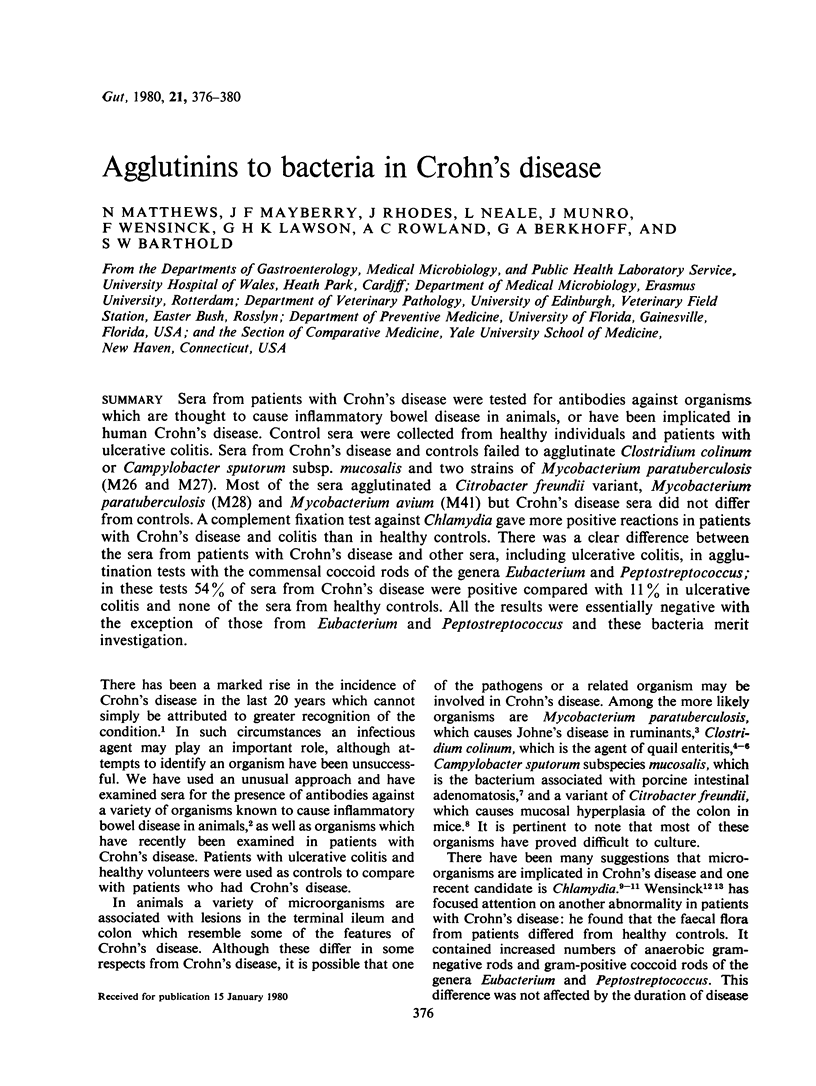Abstract
Sera from patients with Crohn's disease were tested for antibodies against organisms which are thought to cause inflammatory bowel disease in animals, or have been implicated in human Crohn's disease. Control sera were collected from healthy individuals and patients with ulcerative colitis. Sera from Crohn's disease and controls failed to agglutinate Clostridium colinum or Campylobacter sputorum subsp. mucosalis and two strains of Mycobacterium paratuberculosis (M26 and M27). Most of the sera agglutinated a Citrobacter freundii variant, Mycobacterium paratuberculosis (M28) and Mycobacterium avium (M41) but Crohn's disease sera did not differ from controls. A complement fixation test against Chlamydia gave more positive reactions in patients with Crohn's disease and colitis than in healthy controls. There was a clear difference between the sera from patients with Crohn's disease and other sera, including ulcerative colitis, in agglutination tests with the commensal coccoid rods of the genera Eubacterium and Peptostreptococcus; in these tests 54% of sera from Crohn's disease were positive compared with 11% in ulcerative colitis and none of the sera from healthy controls. All the results were essentially negative with the exception of those from Eubacterium and Peptostreptococcus and these bacteria merit investigation.
Full text
PDF




Selected References
These references are in PubMed. This may not be the complete list of references from this article.
- Barthold S. W., Coleman G. L., Bhatt P. N., Osbaldiston G. W., Jonas A. M. The etiology of transmissible murine colonic hyperplasia. Lab Anim Sci. 1976 Dec;26(6 Pt 1):889–894. [PubMed] [Google Scholar]
- Bartlett J. G., Moon N., Chang T. W., Taylor N., Onderdonk A. B. Role of Clostridium difficile in antibiotic-associated pseudomembranous colitis. Gastroenterology. 1978 Nov;75(5):778–782. [PubMed] [Google Scholar]
- Berkhoff G. A., Campbell S. G. Etiology and pathogenesis of ulcerative enteritis ("quail disease"). The experimental disease. Avian Dis. 1974 Apr-Jun;18(2):205–212. [PubMed] [Google Scholar]
- Berkhoff G. A., Campbell S. G., Naylor H. B. Etiology and pathogenesis of ulcerative enteritis ("quail disease"). Isolation of the causative anaerobe. Avian Dis. 1974 Apr-Jun;18(2):186–194. [PubMed] [Google Scholar]
- Berkhoff G. A., Campbell S. G., Naylor H. B., Smith L. D. Etiology and pathogenesis of ulcerative enteritis ("quail disease"). Characterization of the causative anaerobe. Avian Dis. 1974 Apr-Jun;18(2):195–204. [PubMed] [Google Scholar]
- Burnham W. R., Lennard-Jones J. E., Stanford J. L., Bird R. G. Mycobacteria as a possible cause of inflammatory bowel disease. Lancet. 1978 Sep 30;2(8092 Pt 1):693–696. doi: 10.1016/s0140-6736(78)92699-5. [DOI] [PubMed] [Google Scholar]
- Butzler J. P., Dekeyser P., Detrain M., Dehaen F. Related vibrio in stools. J Pediatr. 1973 Mar;82(3):493–495. doi: 10.1016/s0022-3476(73)80131-3. [DOI] [PubMed] [Google Scholar]
- CROHN B. B., TURNER D. A. Porcine ileitis. Gastroenterology. 1952 Feb;20(2):350–351. [PubMed] [Google Scholar]
- George R. H., Symonds J. M., Dimock F., Brown J. D., Arabi Y., Shinagawa N., Keighley M. R., Alexander-Williams J., Burdon D. W. Identification of Clostridium difficile as a cause of pseudomembranous colitis. Br Med J. 1978 Mar 18;1(6114):695–695. doi: 10.1136/bmj.1.6114.695. [DOI] [PMC free article] [PubMed] [Google Scholar]
- Lawson G. H., Rowland A. C. Intestinal adenomatosis in the pig: a bacteriological study. Res Vet Sci. 1974 Nov;17(3):331–336. [PubMed] [Google Scholar]
- Lawson G. H., Rowland A. C., Roberts L. The surface antigens of Campylobacter sputorum subspecies mucosalis. Res Vet Sci. 1977 Nov;23(3):378–382. [PubMed] [Google Scholar]
- Lawson G. H., Rowland A. C., Wooding P. The characterisation of Campylobacter sputorum subspecies mucosalis isolated from pigs. Res Vet Sci. 1975 Mar;18(2):121–126. [PubMed] [Google Scholar]
- Matthews P. R., Brown A., Collins P. The use of polyvalent sera for the serotyping of mycobacteria within the Mycobacterium avium--M. intracellulare--M. scrofulaceum complex. J Appl Bacteriol. 1979 Jun;46(3):425–430. doi: 10.1111/j.1365-2672.1979.tb00840.x. [DOI] [PubMed] [Google Scholar]
- Mayberry J. F., Rhodes J., Heatley R. V. Infections which cause ileocolic disease in animals: are they relevant to Crohn's disease? Gastroenterology. 1980 May;78(5 Pt 1):1080–1084. [PubMed] [Google Scholar]
- Mayberry J., Rhodes J., Hughes L. E. Incidence of Crohn's disease in Cardiff between 1934-1977. Gut. 1979 Jul;20(7):602–608. doi: 10.1136/gut.20.7.602. [DOI] [PMC free article] [PubMed] [Google Scholar]
- Peach S., Lock M. R., Katz D., Todd I. P., Tabaqchali S. Mucosal-associated bacterial flora of the intestine in patients with Crohn's disease and in a control group. Gut. 1978 Nov;19(11):1034–1042. doi: 10.1136/gut.19.11.1034. [DOI] [PMC free article] [PubMed] [Google Scholar]
- Schuller J. L., Piket-van Ulsen J., Veeken I. V., Michel M. F., Stolz E. Antibodies against Chlamydia of lymphogranuloma-venereum type in Crohn's disease. Lancet. 1979 Jan 6;1(8106):19–20. doi: 10.1016/s0140-6736(79)90457-4. [DOI] [PubMed] [Google Scholar]
- Skirrow M. B. Campylobacter enteritis: a "new" disease. Br Med J. 1977 Jul 2;2(6078):9–11. doi: 10.1136/bmj.2.6078.9. [DOI] [PMC free article] [PubMed] [Google Scholar]
- Swarbrick E. T., Kingham J. G., Price H. L., Blackshaw A. J., Griffiths P. D., Darougar S., Buckell N. A. Chlamydia, cytomegalovirus, and Yersinia in inflammatory bowel disease. Lancet. 1979 Jul 7;2(8132):11–12. doi: 10.1016/s0140-6736(79)90176-4. [DOI] [PubMed] [Google Scholar]
- TOMENIUS J., LARRE E., LINDGREN I., BLUMENTHAL B., LINDEWALL G. Positive frei tests in 7 cases of morbus Crohn (regional ileitis). Gastroenterologia. 1963;99:368–373. doi: 10.1159/000202423. [DOI] [PubMed] [Google Scholar]
- Tabaqchali S., O'Donoghue D. P., Bettelheim K. A. Escherichia coli antibodies in patients with inflammatory bowel disease. Gut. 1978 Feb;19(2):108–113. doi: 10.1136/gut.19.2.108. [DOI] [PMC free article] [PubMed] [Google Scholar]
- Taylor-Robinson D., O'Morain C. A., Thomas B. J., Levi A. J. Low frequency of chlamydial antibodies in patients with Crohn's disease and ulcerative colitis. Lancet. 1979 Jun 2;1(8127):1162–1163. doi: 10.1016/s0140-6736(79)91843-9. [DOI] [PubMed] [Google Scholar]
- Wensinck F. Proceedings: The faecal flora of patients with Crohn's disease. Antonie Van Leeuwenhoek. 1975;41(2):214–215. doi: 10.1007/BF02565055. [DOI] [PubMed] [Google Scholar]
- Whorwell P. J., Davidson I. W., Beeken W. L., Wright R. Search by immunofluorescence for antigens of Rotavirus, Pseudomonas maltophilia, and Mycobacterium kansasii in Crohn's disease. Lancet. 1978 Sep 30;2(8092 Pt 1):697–698. doi: 10.1016/s0140-6736(78)92700-9. [DOI] [PubMed] [Google Scholar]


